If you’re running Shopping Ads or trying to grow your product visibility on Google, you’ve probably heard of Google product reviews and product ratings. But what do they really do? And how can you get those golden stars to show up next to your listings?
| In this guide, you’ll learn: ● The difference between Google product reviews and ratings ● Why they matter for Google Shopping performance ● How to get product ratings on Google ● Best practices to build trust and boost clicks |
Let’s get started.
What are Google Product Reviews?
Google Product Reviews are customer feedback and star ratings displayed on a product listing across Google surfaces, including Google Shopping, Google Search, and sometimes also in Shopping Ads.
They can appear as:
- Star ratings (out of 5)
- Total number of reviews
- Short snippets of written feedback
These ratings are not just a nice visual; they influence your click-through rate (CTR), user trust, and ultimately, your sales.
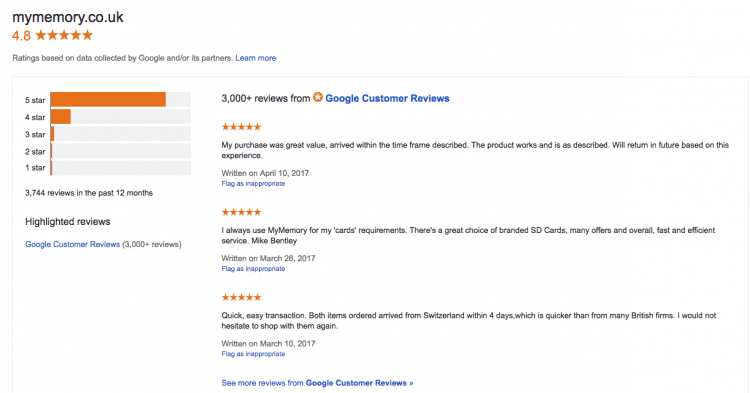
Google Product Ratings vs. Google Product Reviews: What’s the Difference?
Although these two terms are often used interchangeably, Google product ratings and Google product reviews serve different purposes. Here’s how they compare:
| Feature | Google Product Ratings | Google Product Reviews |
|---|---|---|
| What it is | The average star score (1–5) shown under a product | The written feedback customers leave |
| Where it appears | In Shopping Ads, Google Search, and Google Shopping listings | On product detail pages, review feeds |
| Data source | Aggregated from multiple review providers and platforms | Directly submitted by customers |
| Format | Numerical (e.g. ★★★★☆) | Text-based comments + optional rating |
| Purpose | Offers a quick visual of product quality | Provides detailed context and social proof |
| Used for ranking | Yes (impacts ad visibility and trust factor) | Indirectly (used to calculate ratings) |
Put simply, ratings are the summary, reviews are the details. You need both to establish product credibility.
- Google product ratings: The average star score shown under a product, compiled from multiple review sources.
- Google product reviews: The individual feedback or comments left by customers.
Why Google Product Ratings Matter for Google Shopping
Product ratings aren’t just cosmetic; those stars can directly influence how often your products are seen, clicked, and purchased.
Higher Click-Through Rates (CTR)
With a star rating display, the product listing breaks the monotony of a sea of results. The visual element grabs much-needed attention compared to a sterile listing.
Even if your product is costlier, a 4.7-star rating can push a shopper to click on your listing before others.
Stronger Social Proof
Other customers’ reviews are better than any sales pitch. Actual feedback from buyers provides double assurance.
Ratings are like immediate approval, with product ratings a thumbs-up from the crowd, even more so for new or unknown brands.
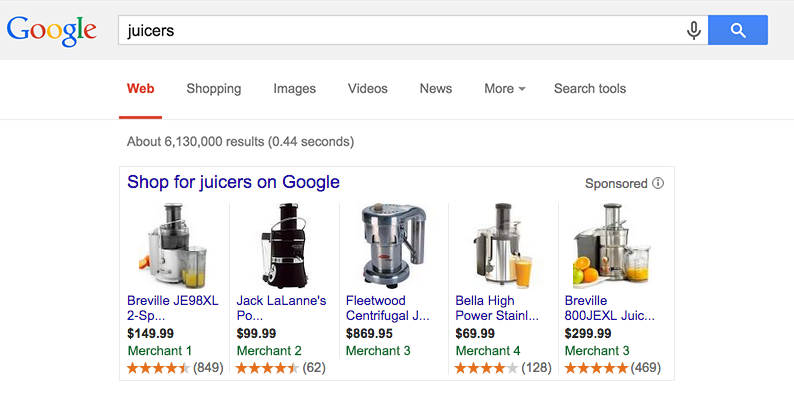
Higher Conversion Rates
If customers are sure about a product, they are likely to go all the way and buy; ratings reduce hesitation during the decision-making.
Hence, star listings don’t just attract more clicks but convert better after users reach the landing page.
Real Numbers, Real Impact
According to Google, adding product ratings can increase CTR by up to 17%. That’s a significant lift in visibility and traffic with no extra ad spend.
In competitive markets, those stars can be the difference between getting noticed or getting skipped.
How to Get Your Product Ratings on Google Shopping
Getting your product ratings to show up on Google Shopping isn’t automatic; it requires the right setup and proper data integration. Here’s exactly what you need to do:
Step 1: Collect at Least 50 Product Reviews
If you want Google to show your product ratings, you have to have at least 50 product-specific reviews listed for your merchandise. This means there must be a total of 50 reviews across all products in the catalog that your store runs; there is no restriction to having 50 per product.
Tip: If you’re starting from scratch, try to focus on collecting reviews for your best goods first. Post-purchase email requests or small incentives, such as discount coupons, can accelerate this process.
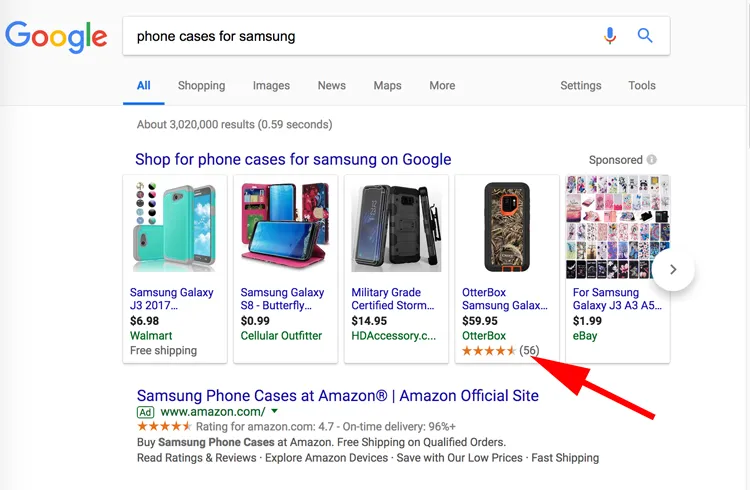
Step 2: Use an Approved Review Aggregator or Feed Source
Google only accepts review data from certain approved sources. You have three main options:
1. Google Customer Reviews (Free & Native)
This is Google’s program that lets you collect reviews from verified buyers after checkout. It is free and directly integrates with your Merchant Center.
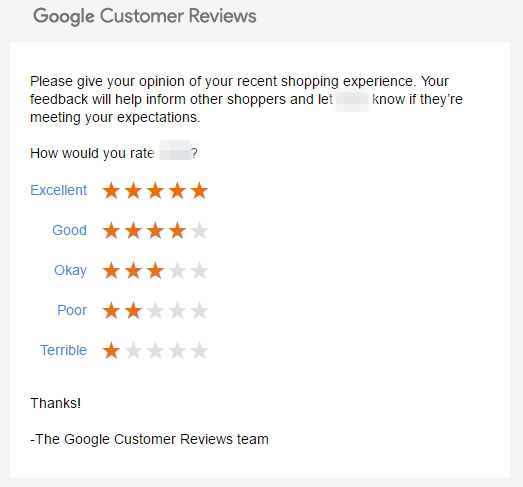
>>> Read more: How to set up Google Product Review Feed in 5 Minutes [2025]
2. Third-Party Review Platforms
You can work directly with select other platforms supported by Google. Examples are Trustpilot, Yelp, G2. These tools allow you to collect and display reviews on-site while pushing structured review feeds to Google on your behalf.
3. Submit Your Own Product Review Feed
If you manage your reviews in-house or use a custom platform, then you can submit your own product review XML feed through Google Merchant Center. Having said that, you had better strictly follow Google’s Product Ratings feed specification or else it may never get approved.
Note: If you’re using Shopify, Google Reviews Importer makes this process easier. The app lets you import reviews directly from your Google Business Profile and formats them into a feed structure that’s compliant with Google’s requirements, so your product ratings have the best chance of being approved and displayed.
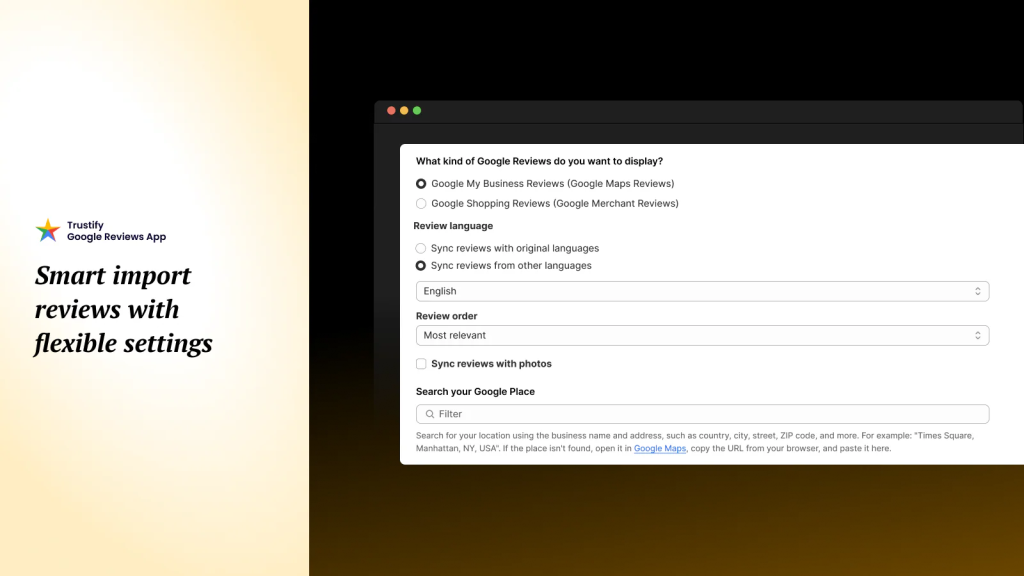
Step 3: Match Reviews to Products Using Proper Identifiers
To link reviews to the correct product listings, you must provide consistent and valid product identifiers, such as:
- GTIN (Global Trade Item Number): Strongly preferred by Google
- MPN (Manufacturer Part Number) + Brand: Alternative if GTIN isn’t available
- SKU: Helpful for internal tracking, but not always used by Google
Without these identifiers, your reviews may never show up in Google Shopping results, even if they have been submitted correctly.
✅ Pro Tip: Using Trustify Google Reviews Importer, you can ensure that imported Google reviews are accurately matched to your Shopify products using key identifiers like GTIN, MPN, or Brand. This increases the likelihood that your product ratings will display correctly in Google Shopping, without any manual mapping.
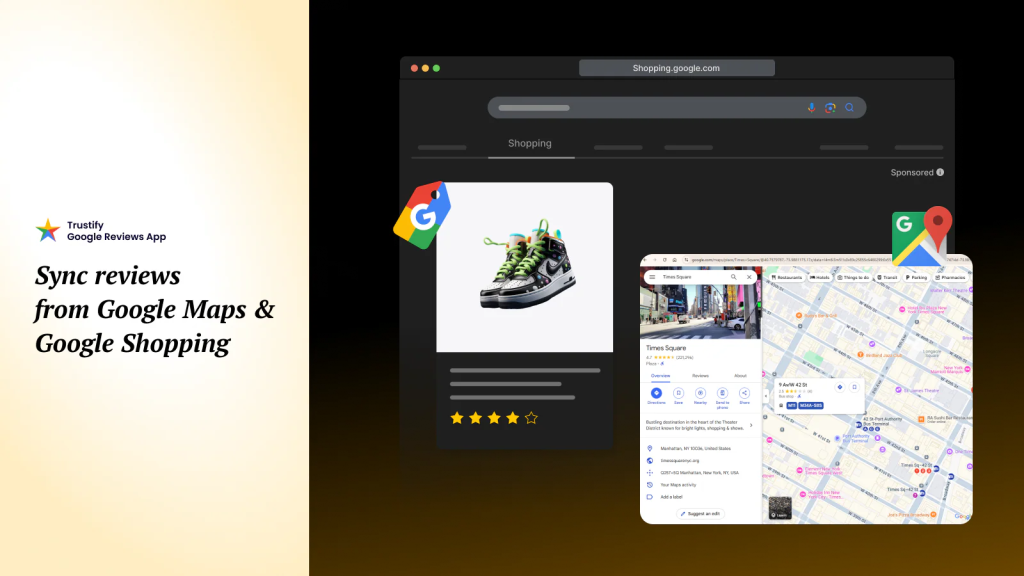
Step 4: Wait for Google Approval
Once you’ve submitted your feed and linked it correctly, Google will review your data. The whole process could last anywhere between 2 and 4 weeks, depending on the volume and accuracy of your feed. Upon approval, your product ratings will start appearing on eligible listings all by themselves.
Best Practices to Maximize Google Product Review Impact
Collecting reviews is just the beginning; what you do with them matters just as much. These best practices will help you turn product reviews into a real competitive edge.
Encourage Customers to Leave Reviews
The more reviews you gather, the more complete and credible your product rating becomes. Instigating customers to review will help you more than sitting back and waiting for reviews.
The more reviews you gather, the more complete and credible your product rating becomes. Instigating customers to review will help you more than sitting back and waiting for reviews. Small incentives, discount codes, or loyalty points can help encourage more buyers to share their experiences.
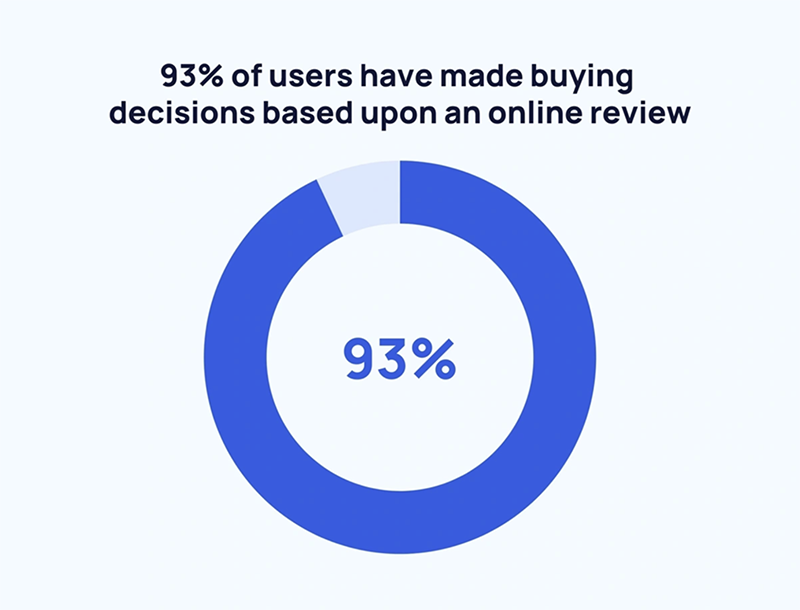
Display Reviews Publicly on Your Store
Google favors transparency. Showing your product reviews directly on your product pages not only helps with Google’s review feed approval but also boosts buyer trust.
When shoppers see that you’re not hiding feedback, good or bad, they’re more likely to believe in the authenticity of your ratings and feel confident about buying.
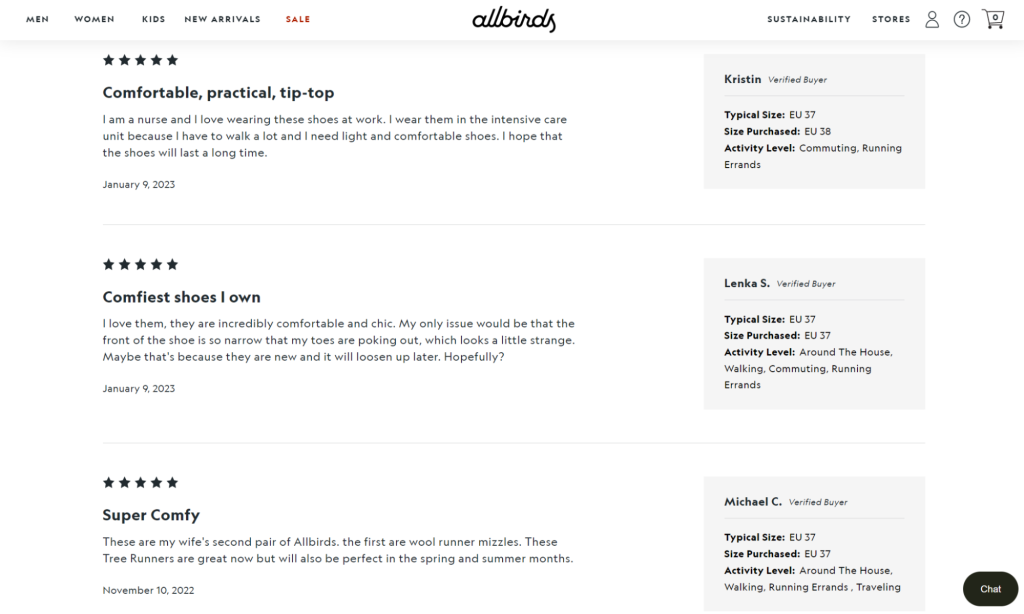
Keep Your Product Review Feed Fresh
Outdated reviews can reduce credibility. Google values freshness in your review feed, so make sure it’s being updated regularly, ideally every few days or at least weekly.
Most review platforms let you automate review syncing with Google Merchant Center. Regular updates also help highlight your most recent improvements, like faster shipping or new features.
Respond to Negative Feedback Professionally
Negative reviews are inevitable. It is really about handling them. A calm, helpful response can turn a bad impression into a trust-building moment. If buyers witness you responding to complaints in a dignified public manner, it assures them that you value customer experience and that you will be there should something go wrong.
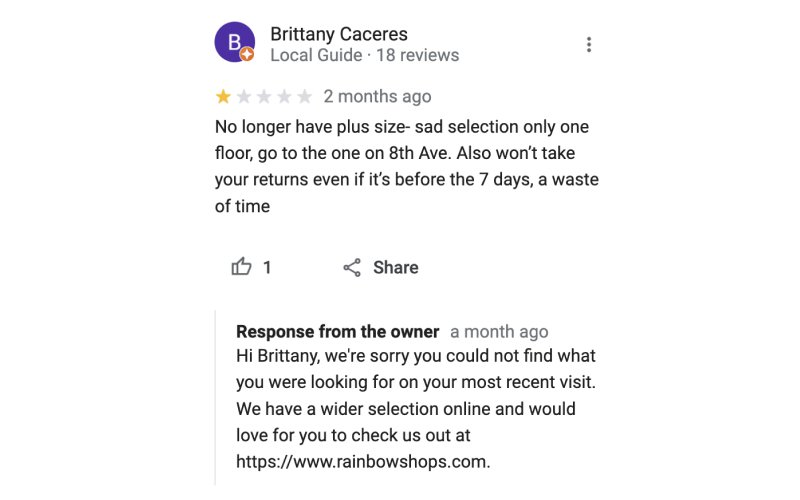
Don’t Manipulate Reviews Unethically
While it’s perfectly fine to encourage reviews, avoid offering rewards in exchange for positive reviews or filtering only 5-star feedback. This not only violates Google’s Product Ratings policies but can also backfire by eroding customer trust.
Reviews should reflect honest, unbiased opinions. Make it clear that any incentive, if offered, is for submitting a review, not for leaving a good one. Transparency builds long-term credibility, and Google may disqualify manipulated reviews from being published or shown in Shopping listings.
FAQs about Google Product Reviews
1. How long does it take for reviews to show up on Google Shopping?
Once approved, reviews take anywhere between 2 and 4 weeks to get shown; however, if the yield quality is low or if there are some technical issues, Google might take longer.
2. What’s the difference between seller ratings and product ratings?
Seller ratings show the general performance of your store (shipping, service, etc.), whereas product ratings focus on specific products. Both are useful, but product ratings are the only ones displayed in Shopping Ads.
3. Can I remove or edit bad reviews on Google?
No, this is an aspect that Google does not allow businesses to do: removing reviews. The best course of action is to respond professionally and encourage positive reviews to even things out.
Final thoughts
Google product reviews aren’t just icing on the cake; they are truly a competitive edge. In a few simple steps, you will be on your way to gathering ratings with Google Shopping and converting social proof into a cash register!
Whether you’re using a review app or building your own feed, the key is consistency. Keep collecting, keep improving, and let your happy customers do the selling for you. Tools like Trustify help ensure your product data is properly formatted and synced with Google, giving your reviews the best chance to show up and convert.